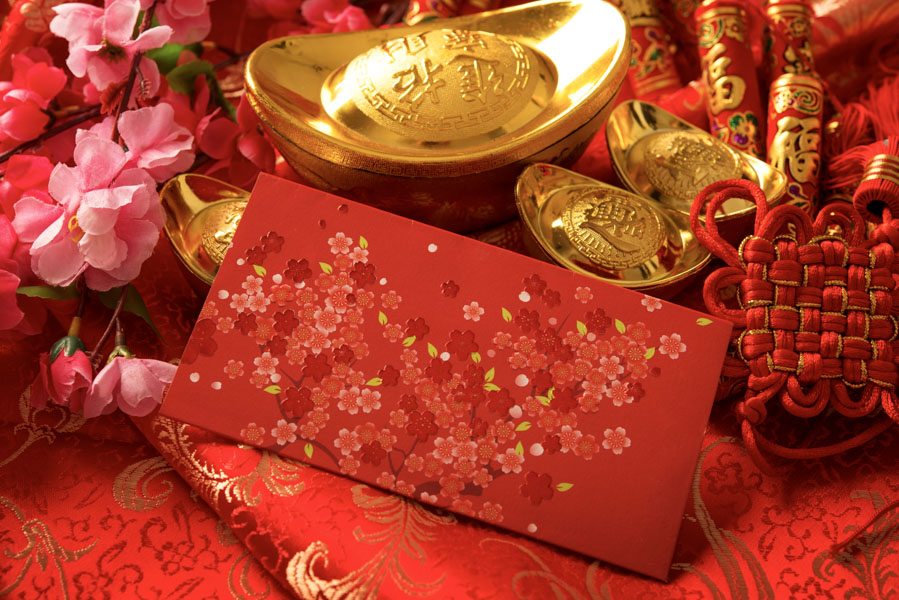
Imagine a world where ancient beliefs take tangible form, enduring through images, colours, and symbols. A world where the crane signifies longevity, fish safeguard peace and harmony, and a coin serves as the protector of prosperity. Chinese symbols of good luck and abundance reflect deep philosophical thought and the collective memory of generations. They originate in myth, take shape in ceramics and silk, and come alive during festivals and in the courtyards of traditional homes. Each symbol tells a story of the human quest for happiness, harmony, and prosperity. This guide explores the meanings behind the most iconic Chinese symbols that continue to influence contemporary culture, architecture, and art.
Animals and Nature: The Language of Symbols and Signs

The world of Chinese symbols lives in the movements of animals, the curves of branches, and the shimmer of water. Every creature and plant carries a specific wish: birds evoke harmony, aquatic life symbolises family happiness, and the delicate branches of shrubs remind us of resilience. These motifs appear in temple murals, porcelain, and on the carved doors of antique screens. Travelling through China is like reading an unending book of nature, where every flower and animal speaks the language of fortune and prosperity.
Bamboo: A Paragon of Integrity, Longevity, and Resilience
Revered as a symbol of integrity and flexibility in feng shui and regarded as one of the Three Friends of Winter alongside pine and plum, Bamboo (竹, zhú) holds enduring significance in Chinese culture. Its segmented growth reflects moral uprightness, and its hollow structure signifies modesty. Known for its resilience, bamboo bends without breaking, embodying strength and continuous progress. Used through centuries in construction, warfare, and paper, bamboo also adorns architectural wonders like Ganlan homes for the Dai, Jingpo, Zhuang, and other minority groups. Essential to craftsmanship, exquisite furniture and the traditional dizi (笛子) flute are made of bamboo. Additionally, spring bamboo shoots are braised or featured in elaborate savoury dishes in Chinese cuisine. Bamboo remains a recognizable cultural motif in Chinese painting, poetry, and calligraphy, where it signifies strength and moral refinement. To experience its natural landscapes, visitors can explore the Shunan Bamboo Sea in Sichuan Province, including the scenic Emerald Gallery walkway.

Bat: Winged Messenger of Fortune
In China, the bat (蝙蝠, biānfú) carries unexpected meaning. Unlike in many Western cultures where bats are often associated with fear, their image inspires delight, as the character 蝠 (fú, bat) is a homophone of 福 (fú), meaning “good fortune”. This linguistic coincidence gave rise to a tradition that transformed the nocturnal creature into a bearer of good luck. A pair of bats is believed to enhance good fortune, while five together represent the ‘Five Blessings’ (五福, wǔ fú): longevity (壽), wealth (富), health and peace (康寧), love of virtue (攸好德), and a peaceful death (考終命). These symbols often appear subtly within decorative patterns, making their discovery an engaging visual game. As you wander through shopping streets, look closely at porcelain, fabric, and embroidery – good luck may be hidden in the details.
Crane: Graceful Emblem of Nobility
Currently on the IUCN Red List of Threatened Species, the crane (鶴, hè) has long symbolised inner harmony in Chinese tradition. Its slow, dignified movements and upright posture associate it with longevity and wisdom. According to legend, the Taoist Eight Immortals (八仙, Bāxiān) ascend to the heavens on red-crowned cranes, which is why the bird represents purity and nobility. On scrolls and porcelain, cranes are often shown beside pine trees, signifying steadfastness and long life, or among peaches, reinforcing wishes for prosperity. A pair of cranes stands for family harmony, as the word 鶴 (hè) echoes 合 (hé) – ‘unity’ or ‘togetherness’. Seek out these elegant images in temple frescoes and golden silk embroideries – each one carries a quiet blessing for a dignified and harmonious life.
Deer: Elegant Symbol of Abundance and Immortality
Thanks to the word’s phonetic resemblance to 禄 (lù), meaning income, honour, or official reward, the deer (鹿, lù) entered Chinese symbolism as an emblem of prosperity. In ancient lore, deer are also said to locate the sacred Língzhī (灵芝) mushroom, associated with immortality. As you stroll through the Summer Palace or the Forbidden City in Beijing, you may notice refined deer statues – their poise reflecting the elevated status of past emperors. The deer also represents filial devotion, its gentle nature evoking respect for elders and ancestors. Decorative deer figurines, often found in flea markets and shops, make meaningful souvenirs that carry wishes for wealth and respect.
Fish: Reflection of a Blessed Life

Abundance and good fortune are the two main characteristics attributed to the fish (鱼, yú). Its name sounds like 余 (yú), meaning ‘surplus’, making it a metaphor for having more than enough. Goldfish (金鱼, jīnyú) are especially valued, their colour linked with wealth and affluence. Pairs of fish represent marital harmony and domestic happiness. In Buddhist thought, a pair of golden fish is one of the eight auspicious symbols (Ashtamangala). They symbolise freedom from suffering, as they swim unhindered in water, and the joy of spiritual liberation. At West Lake in Hangzhou, 180 kilometres (112 miles) southwest of Shanghai, at the Flower Harbor (Huagang Guanyu) scenic spot, you can watch and feed brightly coloured koi carp swimming among the lotus plants.
During the Spring Festival, fish imagery is everywhere: in celebratory dishes at family feasts and in vibrant parades featuring giant fish-shaped lanterns in city squares.
Lotus: Flower of Noble Purity
The lotus (荷花, Héhuā) is a timeless symbol of beauty and purity in Chinese culture. Its perfect symmetry and graceful form appear on the walls of Buddhist temples and shrines, where it conveys serenity and spiritual awakening. Traditionally, the lotus is said to bloom on the eighth day of the lunar month of April in Beijing, a date associated with Buddha’s birthday. It is also linked with the eighth day of the lunar month of January, which is observed as Lotus Day. Lotus motifs are widely used in ceramics and embroidery, where they lend a distinctive and graceful character to these traditional decorative arts. Each summer in recent years, Beijing’s Lianhuachi Park has hosted vibrant Lotus Culture Festival, with thousands of lotus plants and hundreds of varieties in bloom. Additionally, Chinese architecture draws inspiration from this flower – most notably the Lotus Building in Changzhou’s Wujin District in southern Jiangsu, whose design mirrors its petals in a striking expression of harmony between humanity and nature.
Magpie: Melodic Harbinger of Happiness
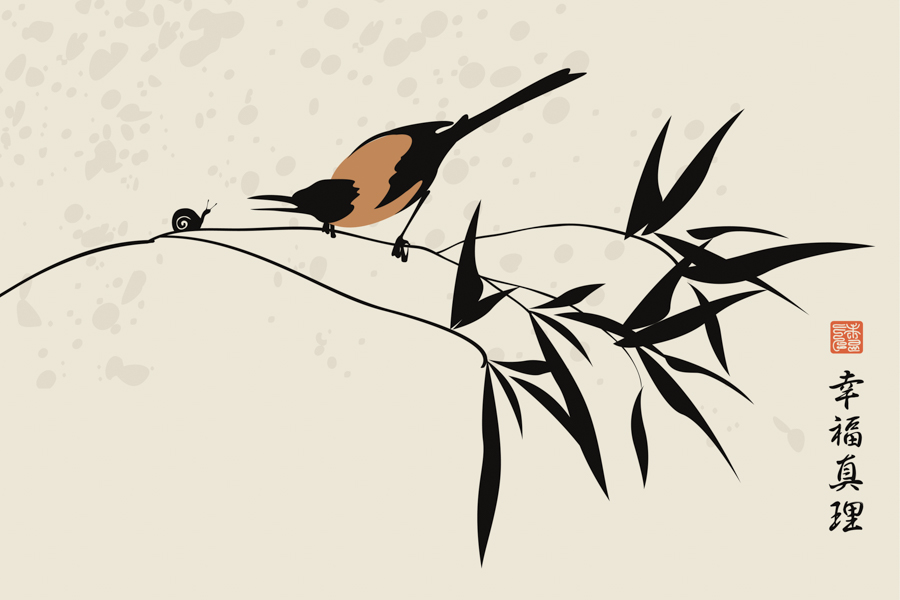
As a joyful messenger and bearer of good news, the magpie (喜鹊, xǐquè) brings tidings of happiness and the arrival of cherished guests. In traditional art, magpies appear in pairs perched on plum or peach branches, representing joyful reunions. Jingdezhen porcelain often features such scenes, surrounded by blossoming trees – symbols of spring and renewal. When in China, look for depictions of magpies in antique stores and folk markets, such as Liulichang Cultural Street in Beijing (琉璃厂文化街), the enclave of Tianzifang (田子坊) in the French Concession area of Shanghai, or the stalls of Xi’an. A magpie figurine or panel brings not only beauty but also wishes for joy and smooth days ahead.
Peach: Fruit of Immortality
In Chinese mythology, the peach (桃, Táo) stands for immortality. Legends tell of Xi Wangmu, the Queen Mother of the West, who offers divine peaches to the gods, granting them eternal life. This powerful symbol of longevity appears in Ming dynasty tapestries and inspired countless artworks. In spring, the Peach Blossom Festivals in Hangzhou, Suzhou, Chengdu, Xianju, and Ningbo fill parks and orchards with a pink haze of blooms. Visitors have the choice to attend live contemporary music concerts or Chinese opera and traditional tea ceremonies, taste delicacies made of the precious fruit or exchange ideas with the local artists. Exhibitions and markets celebrate the season, and by summer, visitors can join in harvesting the sweet fruit – a living echo of ancient belief.
Plum Blossom: Bloom of Resilience and Hope
More than a winter flower, the plum blossom (梅花, méihuā) is a cherished symbol of resilience in Chinese culture. Artists and scholars have long admired its ability to bloom in the cold, making it one of the ‘Four Gentlemen’ or ‘Four Plants of Virtue’ (四君子, sì jūn zǐ) alongside orchid, bamboo, and chrysanthemum, as well as one of the Three Friends of Winter alongside bamboo and pine. It embodies purity, strength in adversity, and enduring hope. In Xi’an’s historic Shu Yuan Men district, you can find scrolls and paintings of plum blossoms – a poetic memento of inner strength and perseverance.
Colours and Numbers: Formulas for Prosperity

The inhabitants of the Middle Kingdom (中国) pay particular attention to colours and numbers, both of which contribute to a significant code of good fortune. They express joy, reflect knowledge and depth, attract wealth, and elevate the spirit. These symbols are embedded in daily life – in clothing, architecture, festivals, and rituals – creating a harmony in which ancient meanings subtly intertwine with the modern world.
Red: Colour of Joy, Fortune, and Celebration
Known for its association with happiness, vitality, and protection from evil, the colour red (红色, hóngsè) features prominently in life’s most joyous occasions, from weddings to New Year festivities. Etiquette suggests that brides traditionally wear red to invite good luck and harmony into their new family, while homes are adorned with red Double Happiness (囍) symbols. During holidays, red lanterns line the streets, representing prosperity, wealth, and honour. Red envelopes filled with money (hóngbāo) convey good wishes, and national celebrations are marked by performances in vivid red – a colour that has come to symbolise the nation itself. In astrology, red is linked to auspicious zodiac signs and elements, enhancing good fortune. As you travel through China, observe how red permeates all spheres of life, filling spaces with a sense of joy and well-being.
Black: Shade of Power and Depth
Black (黑色, hēisè) carries profound philosophical meaning. It appears in architecture, traditional clothing, and the practical logic of feng shui. Black holds a fascinating connection to good fortune, as it is thought to repel bad luck and safeguard individuals from negative spirits during important life events. Black represents power, resilience, and wisdom. Associated with the north and the water element – the origin of life – it held cultural significance in many areas. The Hanfu (汉服), the traditional dress of the Han people, was commonly black, and black ink (mò) became the medium of calligraphy, an art grounded in focus and inner strength. The roofs of schools and scholars’ residences were tiled in black, and temples dedicated to the sea goddess Mazu (媽祖) in Nanjing and Guangzhou bear black ornamentation. As you explore ancient Chinese cities, look for black lacquered gates, Yixing clay teapots, and minimalist textile patterns – each reflecting the ideals of inner clarity, restraint, and strength.
Eight: The Lucky Number of Success
The number eight (八, bā) is the most auspicious number in China, as it sounds like 发 (fā) – “to prosper” or “to get rich.” This association makes it a ubiquity in daily life: in phone numbers, addresses, wedding dates, and business contracts. Eight signifies endless growth, which is why many shops choose to open on August 8 (8.8), a day believed to bring prosperity. The most notable example of this belief is the Beijing Olympics, which officially began on 08.08.2008 at 8:08:08 p.m., a symbolic wish for national success. As you travel through China, look for architectural references to this number – eight temple steps, octagonal pagodas, or eight-petal motifs in carvings. These are not random; they express the belief that fortune follows those who align with the power of eight. Among the most renowned temples are the Eight Trigram Pavilion in Qingyang Gong, Chengdu, and the Eight Temples in Badachu Park, which include Chang'an Temple, Lingguang Temple, Sanshan Temple, Dabei Temple, Longquan Temple, Xiangjie Temple, Baozhu Cave, and Zhengguo Temple in Beijing. Additionally, the Temple of the Eight Immortals in Xi’an is also worth a visit.
Nine: Essence of Majesty and Eternity
Pronounced similarly to 久 (jiǔ), which means “eternity” and is central to expressions of long life and enduring harmony, the number nine (九, jiǔ) symbolises longevity, strength, and imperial authority. Nine was reserved for the emperor, linking the earthly realm with the celestial: rooftops in the Forbidden City feature nine animal figures, palace gates display nine rows of nails, and the iconic Nine-Dragon Wall (九龙壁, Jiǔlóngbì) represents the sovereign’s might. Seek out the presence of nine in Chinese art, design, and ritual – it reflects the pursuit of stability, nobility, and timeless order. Integrated into daily life, the language of flowers and the number of pieces you receive combine to deliver a powerful message in Chinese. In Chinese flower-gift tradition the number 9 is seen as symbolising enduring love; for example, a bouquet of nine roses can imply “we will be together forever”. A bouquet of 99 roses commonly signifies “I will love you for eternity” (often expressed as “as long as the sky and earth endure”). Occasionally, 999 roses may be used to express an even stronger sentiment of unending devotion.
Cultural Symbols: Designs that Illuminate Tradition
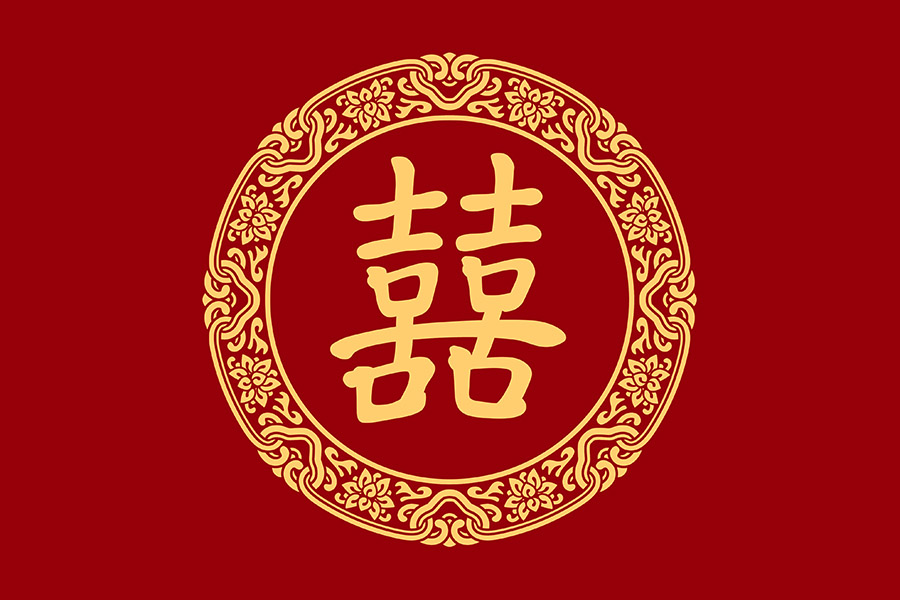
China’s decorative arts conceal a rich world of hidden meanings. Ornaments, inscriptions, and patterns – from celestial clouds and infinity knots to stylised characters and constellations –turn everyday objects into bearers of symbolic intent. These motifs protect the home, strengthen relationships, and serve as quiet reminders that good fortune is never far away.
Auspicious Clouds: Gift from the Heavens
The flowing forms of auspicious clouds (祥云, xiángyún) have long been a beloved motif in Chinese art. Representing the vital energy qi in Taoist cosmology and associated with the link between heaven and earth, cloud patterns convey blessings and favourable omens. Their appearance also foretells rain and, by extension, a good harvest, reflecting ancient hopes for prosperity. Whether rendered in delicate blue on ceramics of the Ming and Qing dynasties or brushed across scroll paintings in fluid ink, auspicious clouds signify good fortune, heavenly grace, and the harmonious connection between the mortal and the divine. Cloud motifs were coupled with animal designs during the Liao dynasty and were later transmitted to Central Asia, Iran, and Japan. The Changsha Mawangdui Han Dynasty Tombs Exhibition at the Hunan Provincial Museum displays numerous lacquer items, some decorated with auspicious cloud patterns.
Pan Chang Knot: Mandala of Endless Life
The Pan Chang Knot (盤長結) embodies the Buddhist philosophy of life’s infinite cycle – without beginning or end. This intricate symbol, often seen as a simple ornament, is believed to bring longevity and happiness to those who display it. Its woven form reflects the Buddhist worldview of interconnectedness and continual rebirth. Throughout the country, such knots are often hung at the entrances of homes and temples as protective charms. Vibrant red versions, sold in markets like Shanghai’s Yuyuan Bazaar and Beijing’s Hongqiao Market, are given as blessings – offering safety on a journey or harmony within the household.
Double Happiness: Mark of Joyful Union
The Double Happiness character (囍, shuāng xǐ) is one of China’s most iconic symbols. Composed of two mirrored versions of the character for joy (喜), it represents harmony in love and a joyful marriage. The symbol dates back to the Tang dynasty, when a scholar passed the imperial exam and wed on the same day – a double blessing preserved in a single emblem. Today, red 囍 characters adorn wedding venues, doorways, and gift boxes, filling the atmosphere with hope for a blissful union. From embroidered ribbons and tea sets to carved lanterns, the symbol is a constant presence at Chinese weddings, carrying wishes for lasting love and family happiness.
Fu, Lu, Shou: The Three Stars of Blessing
Fu (福), Lu (禄), and Shou (寿) – the deities of happiness, prosperity, and longevity – hold a revered place in Chinese tradition. Their origins lie in ancient star lore, where they represent Jupiter, the Big Dipper, and the star Canopus. Statues of the three elders, often smiling and dressed in traditional robes, are displayed together in homes. Fu grants happiness, Lu bestows career success and material wealth, and Shou, with his peach and staff, ensures long life. Their likenesses are common in temples, shops, and homes in cities like Hong Kong, Xi’an, and Guangzhou, and they remain popular gifts for festivals and housewarmings – enduring symbols of a well-rounded and fortunate life.
Mythological Creatures: Guardians of Power and Wisdom
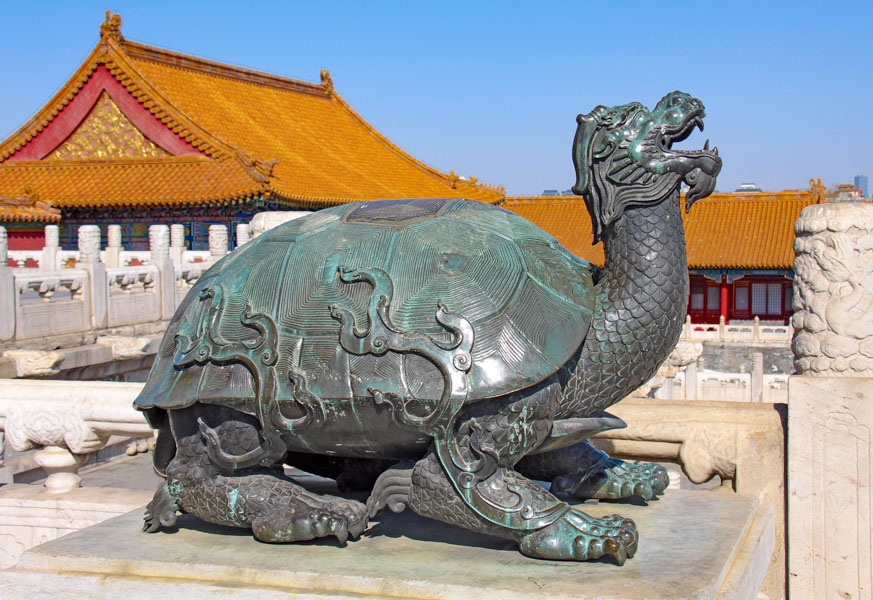
Ancient Chinese legends bring to life mythical beings whose power flows through the sky, earth, and water. The dragon bestows prosperity, the phoenix embodies virtue and renewal, and the tortoise preserves wisdom and tranquillity. Their images still appear today in calligraphic scrolls and expertly carved stonework, preserving the legacy of ancient beliefs.
Dragon: The Breath of Good Fortune
Among all the symbols of Chinese good fortune, none is more vivid than the dragon. Since ancient times, it has been linked with rain, fertility, and the masculine cosmic force of yang, bringing growth and abundance. During national festivals, the dragon is brought to life in the traditional folk long wu (Dragon Dance), where dozens of performers animate a twisting, colourful figure crowned with a fierce, open-mouthed head. You can bring a piece of this dynamic symbol home: artisans at the Hong Kong Jade Market craft elegant dragon figurines from stone, kept as talismans believed to carry the energy of prosperity and protection within the glow of jade.
Phoenix: Rebirth and Virtue
Legends tell of a bird rising in flames to signal new beginnings. In China, the phoenix (fenghuang, 凤凰) symbolises virtue, peace, and rebirth, and its appearance is thought to herald harmony and abundance. Its graceful outline decorates fine porcelain and the silk of traditional garments. Unique phoenix figurines can be found at Beijing’s Panjiayuan Antique Market (潘家园古玩市场) or in the Alley of souvenir stalls of Phoenix Hill Park in Sanya, Hainan – elegant mementoes that reflect the enduring ideals of rebirth and grace.
Tortoise: Enduring Life and Wisdom
In ancient Chinese cosmology, the tortoise (龟, guī) represents the structure of the universe. Its domed shell echoes the heavens, while its sturdy limbs support the world below. In temple carvings and stone reliefs, the tortoise appears as a timeless emblem of longevity, wisdom, and peace. Tradition holds that Chinese script originated from divination marks on turtle shells, and tortoises were once prized in both traditional Chinese medicine (TCM) and cuisine. Their form also inspired generations of artists and sculptors. Each spring, near the city of Chongqing, a turtle-shaped island briefly emerges from the Modaoxi River – a rare natural formation that quietly honours the ancient reverence for this creature.
Religious Figures: Spirits of Blessing and Harmony
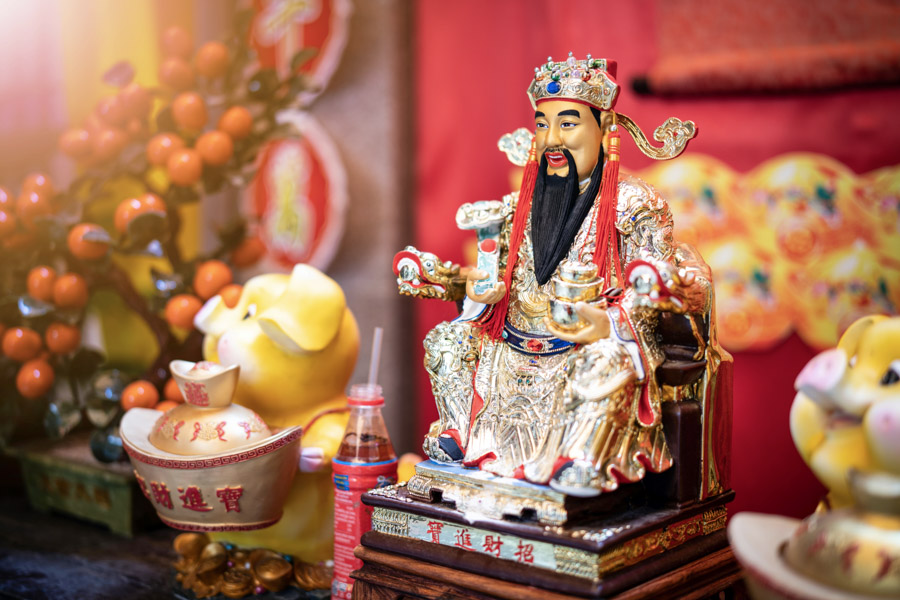
Within the rich tapestry of Chinese culture, certain spiritual figures hold a special place, offering symbols of hope, harmony, and guidance. The Buddha’s serene smile evokes inner peace, Caishen bestows prosperity, and the elegant Ruyi sceptre represents the fulfilment of wishes. These icons bridge the spiritual and earthly realms, helping people seek balance between faith, happiness, and daily life.
Caishen: Fortune at Your Doorstep
When a vivid image of Caishen (财神, Cái Shén) is placed on the front gate and incense is lit in his honour, people in China are calling prosperity into their homes. This benevolent god (or gods) of wealth is a cherished symbol of abundance and financial success, especially revered on the fifth day of the first lunar month. On this occasion, families traditionally prepare Yuanbao Jiaozi (元宝饺子) – dumplings shaped like gold ingots – in the belief that they will attract wealth and good fortune for the year ahead.
Maitreya Buddha: The Smile of Enlightenment to Come
In the calm of Buddhist temples across China, statues of Maitreya Buddha (弥勒佛, Mílè Fó) represent a future age of joy, peace, and spiritual renewal. Depicted with a broad smile and an open, generous posture, he embodies compassion, hope, and inner harmony. Admire the grandeur of the Leshan Giant Buddha (樂山大佛) in Sichuan or reflect in silence beside the golden statue of Maitreya at Beijing’s Yonghe Temple. His image reminds visitors that enlightenment begins with serenity, kindness, and thoughtful reflection.
Ruyi: The Key to Fulfilled Wishes
The Ruyi (如意), a curved sceptre rooted in Buddhist tradition, symbolises wisdom, justice, and the granting of wishes. Its distinctive form – often shaped like a cloud or lingzhi mushroom – made it a treasured item among emperors and scholars alike. Over 3,000 historic examples carved from jade, sandalwood, and precious metals are housed in the Palace Museum in Beijing. Today, the Ruyi is still offered as a decorative charm, often sold online or in cultural shops, carrying the enduring belief that desires guided by wisdom are within reach.
Festive Items: Traditions of Light and Joy

Festive rituals in China fill the air with colour, light, and familiar scents. Each object used during celebrations carries a symbolic wish or hope, turning everyday items into expressions of joy and well-being.
Firecrackers: Sparks of New Beginnings
When firecrackers (爆竹, bàozhú) light up the night sky, their sound and brightness become symbols of change and renewal. During major Chinese festivals – especially New Year’s Eve – firecrackers and fireworks are set off to drive away evil spirits and attract good fortune. Their dazzling bursts above rooftops mark a fresh start and invite blessings into the home. The louder and more vivid the display, the greater the luck believed to follow. Today, the crackle of firecrackers still echoes through the streets of China, ushering in each new year with light and anticipation.
Lanterns: Glow of Hope and Joy
Brilliant colours and soft light are essential to Chinese celebrations. This is especially true during the Lantern Festival, which is celebrated on the first full moon of the lunar year and marks the end of the Chinese New Year festivities. On this day, streets and squares are illuminated with glowing lanterns (灯笼, dēnglóng), creating an atmosphere of warmth and festivity. Thousands of lanterns float skyward, each one a vessel for a wish or a dream. The celebration is accompanied by sweet rice dumplings – tangyuan (湯圓) in the south and yuanxiao (元宵) in the north – symbols of family unity. Some of the most striking displays can be seen in Hong Kong’s Tsim Sha Tsui, Shanghai’s Yu Garden, and along the City Wall of Xi’an.
Red Envelopes: Letters of Luck and Happiness
During Chinese New Year, weddings, and birthdays, red envelopes (紅包, hóngbāo) are exchanged as tokens of blessing and goodwill. These bright envelopes contain money, with the amount less important than the number – even numbers are favoured for their association with balance and harmony. Adorned with characters for wealth, prosperity, and happiness, or with images from the Chinese zodiac, hóngbāo are found in homes, markets, and bookshops across China in the lead-up to major holidays. Neatly packaged sets also make meaningful souvenirs that capture the spirit of celebration and tradition.
Coins and Talismans: Ancient Charms for Modern Fortune

In China, the belief in the power of talismans spans millennia. Small objects – coins, amulets, and pendants – carry wishes for prosperity, long life, and inner harmony. They are exchanged during holidays, kept in homes, and carried daily, with the hope that even the smallest symbol can help guide life in a positive direction.
Ancient Coins & Sycees: Traces of Timeless Wealth
The gleam of ancient Chinese coins or the smooth curves of a gold ingot (元宝, yuánbǎo) continue to evoke ideas of wealth and abundance. In early Chinese thought, the round shape of the coin (方孔钱, fāng kǒng qián) represented Heaven, while the square hole at its centre symbolised Earth – a reflection of cosmic harmony. Sycee silver ingots (元寶, yuánbǎo), once the currency of the elite, are now crafted as miniature replicas and used as symbols to attract prosperity. These items are often displayed on altars or New Year tables and are widely available in shops in Xi’an and Beijing – reminders of an enduring belief in good fortune and abundance.
Chinese Lucky Charms: Keepers of Good Fortune
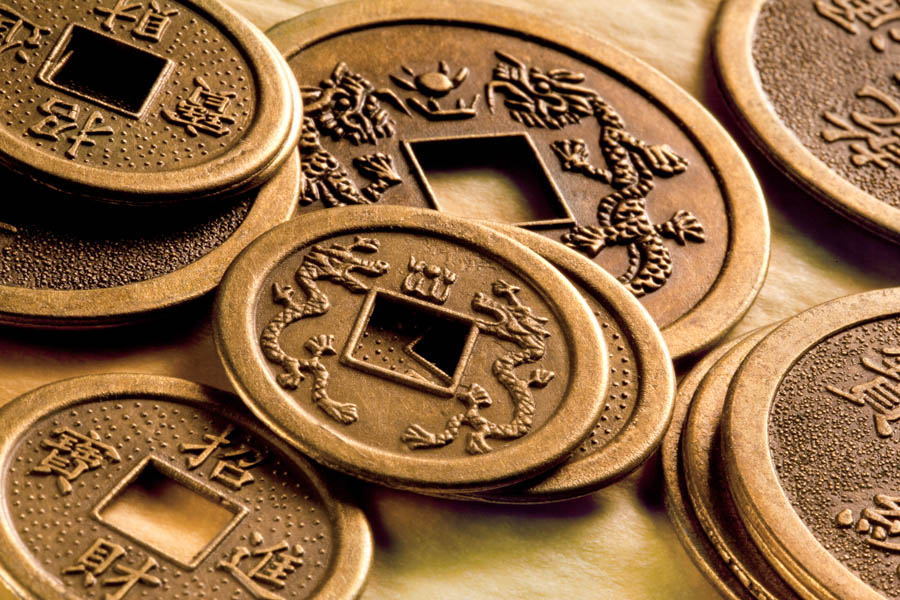
Market stalls and shops across China are filled with talismans, each bearing symbols of luck and protection. Jade pendants are believed to offer spiritual shielding, while Bagua mirrors deflect negative energy. Popular feng shui charms include the three-legged toad holding a coin in its mouth and the amethyst money tree, typically placed near entrances to draw wealth into the home. In Beijing, such charms are commonly found at the Panjiayuan Antique Market, and in Xi’an, in the bustling Muslim Quarter.
Maneki-neko / Lucky Cat: A Sign of Welcome and Luck
Although the Maneki-neko (招き猫) – or “beckoning cat” – originated in Japan, it has become a familiar symbol in Chinese shops and restaurants. Often placed near entrances, these waving cats are believed to attract customers and good fortune. Each colour carries its own meaning: white represents harmony, gold signifies wealth, and pink suggests luck in love. Whether seen in convenience stores, kiosks, or next to incense displays, Maneki-neko figures have become a popular keepsake for travellers – cheerful emblems of welcome, prosperity, and light-hearted charm.
Auspicious Signs: The Language of Hidden Meanings

In Chinese tradition, symbols are rarely used alone. Instead, they are combined into layered compositions where each element enhances the meaning of the whole. A flower beside a bird, or an animal paired with a fruit or stone, becomes a kind of visual riddle of good fortune – readable through colour, form, and outline. This symbolic depth gives Chinese art its distinctive richness, rewarding those who look closely with meanings beyond the surface. Some common combinations include:
- Bat + peaches – a wish for a long and happy life
- Crane + bamboo – a symbol of purity and nobility
- Deer + crane – harmony and connection between generations
- Lotus + fish –a wish for a life of affluence and abundance
- Insects + stones + flowers – a symbol of longevity
These combinations form a visual language through which Chinese culture expresses ideals of harmony, prosperity, and well-being. Patterns, characters, and talismans preserve centuries-old beliefs and hopes. They continue to surround people in everyday life, reminding them that happiness and good fortune often lie in the quiet details and enduring respect for tradition.

